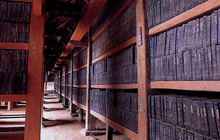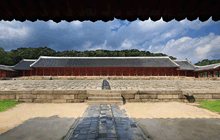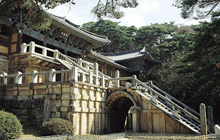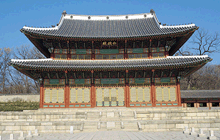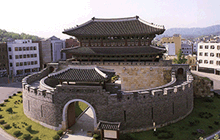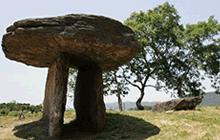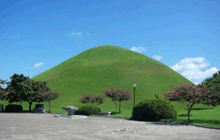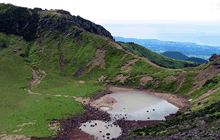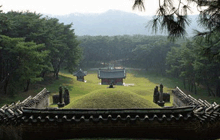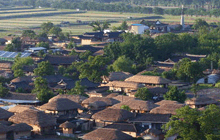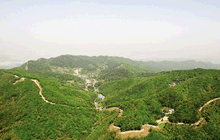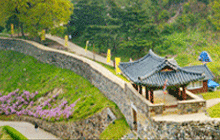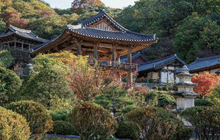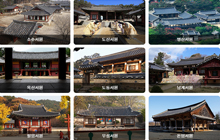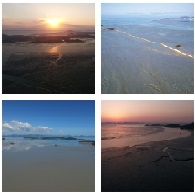
홈
World Heritage
World Heritage in Korea
World Heritage in Korea
There are 16 World Heritage in Korea(Culture 14, Natural 2)
- [Haeinsa Temple Janggyeong Panjeon, the Depositories for theTripitaka...](1995)
Date of inscription : 1995Category : Cultural Criteria : (ⅳ), (ⅵ)Builtduring 13th century in GyunsangNamdo, Hapcheon district, GayaMountain, Haeinsa temple ‘Janggyungpanjeon’ is a storage building for woodblocksuch as ‘Palmandaejanggyung’. It is believed that ‘Panjeon’ was built during 15thcentury on top of hill behind ‘Jubuljeon’ and it was made to store ‘Daejanggyung’in first place. This ‘Panjeon’ is still preserved. Even though ‘Daejanggyung’is made between the two, long middle buildings, there are two small buildingsthat face each other with garden in the middle. The building itself has littledecoration and shows Joseon Dynasty’s wooden structure in its early era.
Source: Cultural Heritage Administration
- [Jongmyo Shrine] (1995)
Registration : 1995Classification: Heritage registration criteria :(ⅳ)Jongmyo Shrine, located in Jongno-gu, Seoul, is a shrine toenshrine ancestral shrines of kings and queens during the Joseon Dynasty. Theking shows the symbolism and legitimacy of the royal ancestral rites in aregular manner to pray for the welfare of the king and the people of the nationwith officers. As the Confucian architecture of East Asia, spatial planning isvery unique and its preservation is excellent. It was built in the late 14thcentury and was reconstructed in the early 17th century after the invasion ofJapan, and was later expanded as needed
Source : Cultural Heritage Administration
- [Seokguram Grotto and Bulguksa Temple] (1995)
Registraioin : 1995Classification: Heritage registration criteria :(ⅰ), (ⅳ)Seokguramand Bulguksa Temple were ancient Buddhist relics made during the Silla Period.Seokguram is a Buddhist temple with statues of Buddha, and Bulguksa Temple is atemple building. Both houses are located in Tohamsan Mountain, southeast ofGyeongju with some distance. The two estates were constructed in the latterhalf of the 8th century and were completed at a similar time. Seokguram is aman-made cave made of granite. The main statue of Buddha (Bonjonbul) is placedat the center of the cave, and other statues like Bosal, Nahan, Sinjang areplaced as well. Bulguksa Temple is a wooden structure built on a manmade stonestylobate, showing the essence of ancient Buddhist architecture. Especially,Pieces of Seokguram and the stone stylobate of Bulguksa Temple and two stonepagodas are regarded as one of the greatest masterpieces of ancient Buddhistart in Northeast Asia
Source: Cultural Heritage Administration
- [Changdeokgung Palace Complex] (1997)
Registration: 1997Classification: Heritage registration criteria :(ⅱ), (ⅲ), (ⅳ)ChangdeokgungPalace is a palace in the Joseon Dynasty located in Jongno-gu, Seoul It is an importantcultural heritage that is not only harmonized with the overall environment ofarchitecture and landscape, but also shows Korean spatial atmosphere. Itis constructed in early 15th century as Sub-Palace, located in theEast side of Gyungbokgung Palace, which is the main palace. Thus, its purposeof construction and location are quite different from those of GyungbokgungPalace.
Source: Cultural Heritage Administration
- [Hwaseong Fortress] (1997)
Registration : 1997Classification: Heritage registration criteria:(ⅱ), (ⅲ)Hwaseong Fortress is thefortress of the Joseon Dynasty in Suwon, Gyeonggi Province. As King Jeongjo moved hisfather, Crown Prince Jangheon’s tomb, he built the fortress for defensivepurpose in order to build a new city where people can migrate to. Construction beganin February 1794 and was completed after two and a half years of construction.The entire fortress is 5.74 kilometers long, and a wall of four to six meterstall is enclosing an area of 130ha.
Source: Cultural Heritage Administration
- [Gochang, Hwasun and Ganghwa Dolmen Sites] (2000) [Hwaseong Fortress] (1997)
Registration : 2000Registrationregistration criteria:(ⅲ)Korea's dolmens are giant stone monuments, a type oftombs that are constructed by using giant stones, and they are divided intothree parts of Gochang, Hwasun, and Ganghwa. More than hundreds of dolmens areconcentrated in one area, and it is difficult to find other similar types inother places in the world in the aspects of diversity and density. Dolmens ofthese three areas are critical heritages for studying Korean Bronze Age, theformation of dolmen culture and cultural exchanges in Northeast Asia.
Source: Cultural Heritage Administration
- [Gyeongju Historic Areas] (2000)
Registration : 2000Classification: Heritage registration criteria:(ⅶ), (ⅷ)Gyeongju isthe capital city of Silla, which retains the 1,000 year history of Silla, andrepresents the cultural and artistic sensibility of Silla people. The GyeongjuHistoric District consists of five districts. These include the Namsandistrict, which contains various Buddhist relics, Wolseong district, a site ofold palaces, Daereungwon district, where many ancient tombs are located,Hwangryongsa temple district, where is a historical site of Buddhism, andlastly Sansung district, where defensive fortresses are located.
Source: Cultural Heritage Administration
- [Jeju Volcanic Island and Lava Tubes] (2007)
Registration : 2007Classification: Natural registration criteria :(ⅶ), (ⅷ)JejuVolcanic Island and Lava Tubes of 18,846 ㎡ are surrounded by dark larva walls and theirceilings and tiles are made of carbonate cave products with variouscolors. Thelegacy of breathtaking beauty shows the history of the earth, includinggeological features and development processes.
Source: Cultural Heritage Administration
- [Royal Tombs of the Joseon Dynasty] (2009)
Registration : 2009Registrationregistration criteria :(ⅲ), (ⅳ), (ⅵ)Royal Tombs of the Joseon Dynasty are scattered in 18 placesand there are 40 of them. Tombs that had been constructed for 5 centuries from1408 to 1966, helped to commemorate and respecte the ancestors, reinforcementkingship, and protected any damage. The Royal Tombs are located in prominentnatural scenery. Usually they are built according to the rule of Baesanimsu,(mountains behind, facing waters) surrounded by mountains in distance, whichseemed to be ideal. Not only does the royal tomb have a burial site, butthere is also a place for a ritual and a gateway.
Source: Cultural Heritage Administration
- [Historic Villages of Korea : Hahoe and Yangdong] (2010)
Registration : 2010Classification : Cultural registration criteria :(ⅲ), (ⅳ)HahoeVillage and Yangjin Village, which were formed in the 14th and 15th centuries,are the historical clan towns that represent Korea. The location and placementof the village in between of mountains and farm lands well reflect theConfucian culture of the Joseon Dynasty. The old village is located in a place whereit can obtain material and spiritual nourishment from the surroundinglandscape. In the villages, there are wooden houses, where ruling classesdwelled, shrines, academies and thatched houses, where commoners lived. Poetsfrom the 17th to 18th century had sung beautiful poems by looking at thescenery of the river, mountains and trees surrounding the village.
Source: Cultural Heritage Administration
- [Namhansanseong] (2014)
Registration: 2014Classification : Cultural registration criteria:ooNamhansanseong Fortress, located 25 kilometers southeast ofSeoul, is constructed as a temporary capital city in the Joseon Dynasty (1392to 1910). Someof heritages of Namhansanseong Fortress were from 7th century, butit as reconstructed many times later especially during the invasion of Qing,founded by Manju people. Namhansanseong was built by the monk army, and theyprotected the fortress. Namhansanseong Fortress is a fortress that reflects theinfluence of Western weaponry, and building technique of China and Japan. Thisfortress implemented defensive military engineering of that era.
Source: Cultural Heritage Administration
- [Baekje Historic Areas] (2015)
Registration : 2015classification : culturalregistration standard :(ⅱ), (ⅲ)Baekje is one of the ancient countries, which existed for 700 years from B.C.18 to A.D.660 in the Korean Peninsula.Baekje historic site is composed of 8 cultural heritages in Gongju-si, Buyeo-gun, and Iksan-si. To see the detailed registered regions, Gongsanseong (historic site no.12) and Songsanri Gobungun (historic site no.13) are in Gongju-si, Chungnam, Gwanbukri historic site and Buso fortress (historic site no.428 and no.5), Neungsanri Gobungun (historic site no.14), Jeongrimsaji (historic site no.301), Buyeonaseong (historic site no.68) in Buyeo-gun, Chungnam, and Wanggungri historic site (historic site no.408) and Mireuksaji (historic site no.150) in Iksan-si, Jeonbuk.
Source : Cultural Heritage Administration
- Sansa, Buddhist Mountain Monasteries in Korea (2018)
Date of inscription : 2018Category : Cultural Criteria : (iii)
Sansa consists of seven Buddhist mountain monasteries—Tongdosa, Buseoksa, Bongjeongsa, Beopjusa, Magoksa, Seonamsa and Daeheungsa—located throughout the southern provinces of the Korean Peninsula. The seven monasteries established from the 7th to the 9th centuries have functioned as centres of religious belief, spiritual practice, and daily living of monastic communities, reflecting the historical development of Korean Buddhism. Sansa has accommodated diverse Buddhist schools and popular beliefs within its precinct, and many of its notable historic structures, halls, objects and documents reflect such assimilating features of Korean Buddhism. The distinctive intangible and historical aspects of Korean Buddhism can be recognized in the continuous traditions of self-sufficient temple management, education of monks, and coexistence of meditative practice and doctrinal studies of Korean Seon Buddhism. These mountain monasteries are sacred places, which have survived to the present as living centres of faith and religious practices despite suppression during the Joseon Dynasty and damages caused by wars and conflicts over the years.Source : Cultural Heritage Administration
- Seowon, Korean Neo-confucian Academies (2019)
Date of inscription : 2019Category : Cultural Criteria : (iii)
The Seowon, Korean Neo-Confucian Academies is a serial property which comprises nine seowon representing a type of Neo-Confucian academy of the Joseon Dynasty (from the mid-16th to mid-17th centuries CE). It is an exceptional testimony to cultural traditions associated with Neo-Confucianism in Korea. The components are Sosu-seowon, Namgye-seowon, Oksan-seowon, Dosan-seowon, Piram-seowon, Dodong-seowon, Byeongsan-seowon, Museong-seowon and Donam-seowon, and these are located across the central and southern parts of the Republic of Korea. The property exhibits an outstanding testimony to thriving Neo-Confucian academies that promoted learning of Neo-Confucianism, which was introduced from China and became fundamental to every aspect of Korea. The local literati at seowon created educational system and tangible structures conducive to fully commit themselves to learning. Learning, veneration and interaction were the essential functions of the seowon which are closely reflected in their design. The seowon were led by sarim or the class of local intellectuals. The seowon developed and flourished as centres for the interests of the sarim. The primary factor in siting the seowon was the association with venerated scholars. The second factor was the landscape, and seowon are located near mountains and water as part of appreciating nature and cultivating the mind and body. Pavilion style buildings in the seowon facilitated connections to the landscape. The scholars studied Neo-Confucian classics and literary works and endeavoured in understanding the universe and becoming ideal person. They venerated late contemporary Neo-Confucian figures, and formed strong academic lineage spearheaded by venerated scholars. Furthermore, local literati made significant contribution to disseminating principles of Neo-Confucianism through various social and political activities based on the property.Source : Cultural Heritage Administration
- Getbol, Korean Tidal Flats (2021)
Date of inscription : 2021Category : Cultural Criteria : (iii)
Along the southwest coast of the Republic of Korea in the east side of the Yellow Sea comprises comprises four component parts: Seocheon Getbol, Gochang Getbol, Shinan Getbol and Boseong-Suncheon Getbol.This property represents one of the most important and meaningful habitats for the conservation of biodiversity and especially, it has international importance as a major stopover site for globally endangered migratory waterbirds in the East Asian-Australasian Flyway.The site exhibits a complex combination of geological and geomorphological, oceanographic and climatologic conditions that have led to the development of a range of habitats for tidal flat organisms including migratory waterbirds. The property also embodies high levels of biodiversity, with reports of 2,169 species of flora and fauna, including 102 migratory bird species. Especially, it is home to 47 endemic and five endangered marine invertebrate species as well as 27 globally threatened or near-threatened migratory waterbird species.The property also demonstrates the link between geodiversity and biodiversity, and responds to how cultural diversity and human activity depend on the natural environment.Source : Cultural Heritage Administration
- Gaya Tumuli (2023)
Date of inscription : 2023Category : Cultural Criteria : (iii)The Gaya Tumuli is a serial property consisting of seven cemeteries created by members of the Gaya Confederacy, an ancient collection of several polities that persisted from the first through the mid-sixth century in the southern section of the KoreanPeninsula.Thesevennominatedcemeteriesare the Daeseong-dong Tumuli, Marisan Tumuli, Okjeon Tumuli, Jisan-dong Tumuli, Songhak-dong Tumuli, Yugok-ri and Durak-ri Tumuli, and Gyo-dong and Songhyeon-dong Tumuli.Through its geographical distribution, locational characteristics, types of burial, and contents of grave goods, the nominated property attests to the distinctive Gaya political system in which affiliated polities were allowed to exist as autonomouspoliticalequalswhilesharingculturalcommonalities. The Gaya Confederacy responded flexibly to political shifts in ancient East Asia and contributed to maintaining the balance of power in the region by cooperating internally and taking part in exchangeswithneighboringstates.The seven nominated cemeteries are the respective burial grounds for the top leaders of seven Gaya polities that developed independently at different sites across the southern portion of the Korean Peninsula. The cemeteries are all located on elevatedterrainatthecenterofa polity and are home to densely clustered tombs constructed over a long period. This dispersed distribution of equally monumental and elaborate tomb clusters manifesting shared practices for siting and building high-statustombs testifiestotheexistenceofmultiple equally powerful and mutually autonomous polities living under the influence of the same culture.The nominated cemeteries all feature a particular kind of stone-lined burial chamber and have produced a distinctive form of pottery, respectively known as the Gaya-type stone-lined chamber burial and Gaya-style pottery. These commonalities contributetoidentifyingtheterritorialboundsof the Gaya Confederacy. Individual variations can still be found within these two indicators, allowing the boundaries of each polity to be identified and testifying to their political autonomy. Other grave goodsbeyondGaya pottery,suchas ironweaponsreflecting similar levels of military power and trade goods imported into and exchanged within the Gaya Confederacy, demonstrate how the seven polities existed as political equals and maintained a level of internalparity.
Source : Cultural Heritage Administration
-

